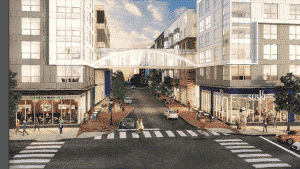
Jefferson Apartment Group is building a 320-unit rental complex with ground floor retail opposite Malden Center station on the MBTA’s Orange Line and the commuter rail’s Haverhill line.
Gateway Cities like Brockton, Lynn and Worcester can play an important function generating more geographically-balanced growth throughout Massachusetts. These communities all have strong transit connections to Boston, which positions them to tap the Hub’s valuable assets, including its major research institutions, sophisticated service providers, skilled workforce and global connections.
As regional centers, the economic activity they generate will spill over into surrounding communities. So transit-oriented development that integrates Gateway Cities with the Boston knowledge economy can propel the state economy forward.
Successful transit-oriented development in Gateway Cities has been limited so far, but this could soon change. Ironically, the centralization of growth in Boston over the past decade signals the possibility. Employment growth is moving from office parks along Route 128 and I-495 to revitalized areas of Boston, Cambridge and Somerville. In part, this back-to-the-city trend is simply a function of employers following Millennials to hip urban neighborhoods, but the pattern also speaks to the region’s ability to absorb growth.
Living nearby is now the only way to have a tolerable commute to jobs in suburban office parks. Suburban towns don’t permit much residential construction, so we can no longer accommodate business expansion in these locations. Theoretically, growth could keep moving further out from Boston, but at some point companies lose the benefits that come with being near Boston, which makes it harder to justify locating in Massachusetts at all.
Growth constraints present opportunity for Gateway Cities in Eastern Massachusetts. These older urban centers all have an abundant supply of developable land and long-vacant properties surrounding their train stations. As locations for infill in the Boston core dwindle, these pro-growth communities could accommodate a substantial amount of future residential and commercial development.
Transit Service Improvements Necessary
Mixed-use infill in these cities would provide a slew of benefits. If Gateway Cities become choice neighborhoods for skilled workers with an easy commute to Boston, Boston employers would get a substantial increase in the effective size of their labor force. With careful attention, the benefits of growth in these inclusive cities could be more evenly distributed, providing a bulwark against growing income inequality. And by leveraging existing infrastructure, dense infill in Gateway Cities will surely produce strong fiscal and environmental returns.
Transit-oriented development in Gateway Cities will be a great boon to communities throughout these rail corridors. Dense development in Gateway Cities could produce much higher ridership, which in turn would necessitate service improvements that benefits everyone in the corridor.
Over time, suburban residents living near rail would also have more options: someone in Winchester might one day find themselves getting a train to a job (or dinner and a movie) in Lowell.
For this scenario to take hold, we must first address some chicken-or-egg problems. Rents in Gateway Cities are too low to support adaptive reuse and infill, and the commuter rail is too infrequent, too unreliable, too expensive and too slow to create significant real estate value. Rail service improvements can boost values, but probably not by enough to close the gaps on their own. Initially, we will need enhanced tools to support mixed-used development and generate activity in Gateway City station areas.
From a new federal infrastructure program to the next procurement for MBTA commuter rail service operations, policy decisions with the potential to solve these problems and fuel TOD in the Gateway Cities are in the offing. Real estate developers who like the challenge of urban infill should have a keen eye on these opportunities.
Ben Forman is research director at MassINC.








